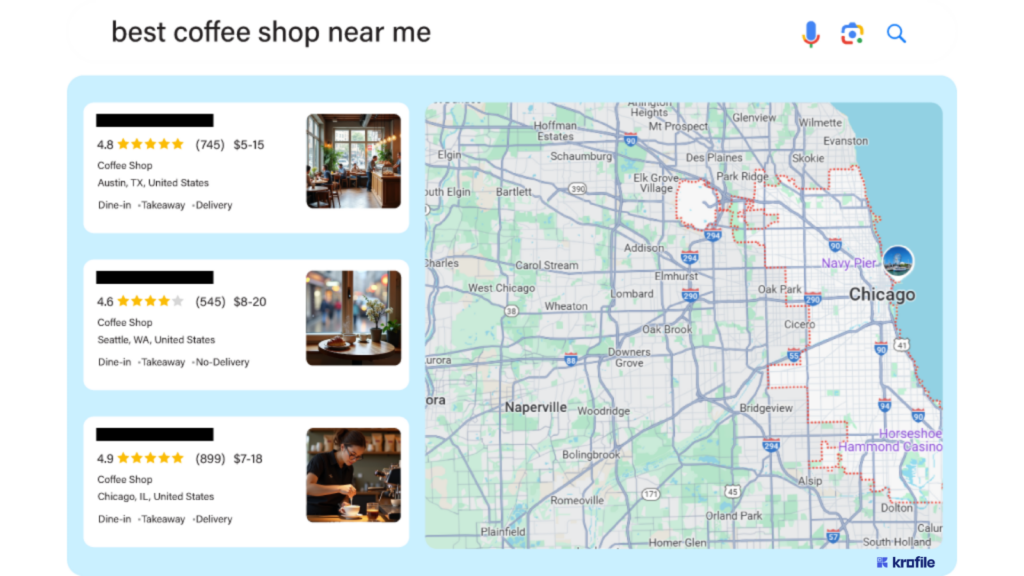Did you know that SEO for restaurants is the most powerful way to grow your restaurant’s online presence? Over the past 20 years, I’ve worked with big brands, small cafes, and startups, helping them dominate Google rankings, attract more customers, and increase reservations without spending a fortune on ads.
In my experience, traditional marketing methods like flyers, billboards, and even social media alone aren’t enough anymore. They help, but they don’t offer the consistent, long-term visibility that an effective SEO strategy does. The good news? SEO for restaurants is easier to implement than most owners realize, and once done right, it keeps bringing in customers without extra effort.
In this guide, I’ll walk you through the proven SEO strategies that have helped restaurants rank higher on Google, show up in “restaurants near me” searches, and turn online traffic into real diners. Whether you run a fine dining restaurant, a family-owned café, or a quick-service spot, these SEO strategies will help you build a stronger online presence, increase reservations, and stay ahead of the competition.
If your restaurant isn’t showing up when people search for places to eat, you’re losing customers every day. But that changes today. Let’s dive in and take your restaurant to the next level with the right SEO strategy.
What is SEO?
SEO stands for Search Engine Optimization. Using SEO strategy, you can rank your website on Google search result pages when people look for the services your business offers. For example, type “best coffee shop near me” in Google, what if it pops up with your coffee shop first? It is possible with the right SEO strategy without spending on Ads.

With the right SEO strategy, your restaurant can:
- Rank at the top when people search for restaurants
- Attract local diners looking for food right now
- Get more online reservations & orders
- Compete with big restaurant chains without spending a fortune on ads
So, if you own or manage a restaurant, mastering SEO for restaurants is one of the best things you can do for your business.
How Google Sees Your Restaurant?
SEO helps people find answers to all their questions from the right place. Google is like a food critic. It analyzes your website and decides:
- Is this restaurant relevant? (Do you have the right keywords?)
- Is it trustworthy? (Do you have good reviews and backlinks?)
- Is the website fast and mobile-friendly? (Users experience matters!)
If your website is slow, outdated, or missing key information, Google won’t rank it high. But if you optimize it properly, you can outrank even the big-name competitors in your area!
Why is SEO a total game-changer?
Here’s what happens when you implement SEO for your restaurant:
1. More People Find You Online
- Instead of hoping people walk past your restaurant, they find you on Google and come directly to you.
2. Free Marketing – Unlike Ads
- Google keeps sending you free customers every day, even while you sleep. No need to pay for ads constantly.
3. More Reservations, More Orders
- A high-ranking restaurant gets more online bookings & takeout orders because customers trust Google’s top results.
4. Stand Out from Competitors
- Even if big brands dominate in your city, SEO helps you compete without spending a massive budget.
5. Builds Trust & Reputation
- Being on Google’s first page makes your restaurant look more trustworthy to customers.
Benefits of SEO for Restaurants
As you may already know, people search for restaurants today, and they grab their phones, put in ‘best restaurant near me’, and pick from the first few vendors. You are losing out if you don’t show up on that list. As a restaurateur, it is your job to apply all required strategies to get your Restaurant on the top search engine listings; that is where SEO comes into the picture.
Let’s explore the benefits of SEO for restaurants:
Reach More Diners Nearby
SEO assists in allowing people in your area to find your Restaurant when they want to or when they search for restaurants near you. Engaging in local searches creates the possibility of more customers, regardless of whether it is a family gathering or a quick coffee break. SEO has everything required to make your Restaurant rank at the top in the SERPs (Search engine result pages).
Let Your Food Shine Online
Considering all the hard work that goes into creating phenomenal dishes, know that your dishes can only be noticed when you use SEO to enhance your Restaurant’s online visibility. Remember, creating a creative menu, eye-catching photographs, and stellar reviews is the best way to get visitors. This is a part of a local SEO technique. In this blog, we will also discuss Local SEO and its strategies.
Save Time, Earn More
SEO requires a one-time, consistent investment to do all the magic! It has been proven that SEO has a long-term impact on audiences after they have been appropriately targeted. This allows the owners to devote their time to something that matters the most – managing their Restaurant’s online presence with SEO.
We are not only acquiring an audience by using SEO but also ensuring that they become our loyal customers. For a better understanding, let’s study what Local SEO is and how it suits restaurants.
Local SEO for Restaurants
Before starting Local SEO, understand this: if a customer wanders into the area of a restaurant, there is a chance that they will visit it. However, with local SEO, the chances of this happening increase by ensuring that your restaurant appears in local searches.

Why is Local SEO Important for Your Restaurant?
- Connect With the Targeted Audience: Local SEO is perfect for restaurants seeking to enhance their visibility. When a potential customer searches online using specific local keywords like “best restaurant near me.” Giving you good chances to appear among the top results. According to recent statistics, 46% of all Google searches are made to find local information.
- Increase in Local Visits: Did you know, 88% of local searches for business done through the mobile device culminate with a phone call or an onsite visit within a period of 24 hours? This indicates that we should optimize our business content for mobile searches, to get more local customers.
- Boost Sales in a Short period: Almost 28%, one in every four local visits ends in a sale in just a single day.
15 SEO Strategies for Restaurants: A Complete Step-by-Step Guide
In this guide, I will walk you through the 15 most important SEO strategies that every restaurant should implement to dominate Google search rankings, attract more diners, and increase revenue. Each strategy will be explained in-depth, from basic concepts to advanced techniques, to ensure you can apply them effectively.
1. Krofile – Create a Digital Business Profile
One of the most powerful ways to boost restaurant’s SEO is by creating and optimizing your Digital Business Profile on Krofile. Many restaurant owners focus only on Google My Business, but Krofile offers a more features and tools that enhances your restaurant’s visibility, credibility, and engagement.
Steps to Optimize Your Krofile Business Profile:
- Claim and verify your restaurant’s Krofile account. This ensures that your business information is accurate and easily accessible for customers.
- Upload high-quality photos. Add menu images, restaurant interiors, food photography, and team photos to enhance engagement.
- Showcase your menu & services. Upload an SEO-optimized digital menu with relevant keywords like “organic gluten-free pasta in NYC” or “affordable seafood restaurant near me”.
- Collect and manage customer reviews with Krofile’s review generation. It automatically prompts customers to leave reviews on their preferred review platforms. The more 5-star reviews you get, the higher your rankings will be.
Optimizing Krofile not only boosts SEO but also enhances brand reputation, builds customer trust, and helps convert searchers into diners.
2. Choosing the Right Keywords for Restaurant SEO
Keywords are the foundation of SEO. If your restaurant does not use the right keywords, you won’t rank on Google when people search for your type of food. Did you know, that almost 85% check the reviews before making purchasing decisions.
How to Find the Best Keywords for Your Restaurant:
- Primary Keywords: These should be short and location-specific (e.g., “Best Italian restaurant in Chicago”, “Top seafood place in Miami”).
- Long-Tail Keywords: These are longer, more detailed phrases that customers search for (e.g., “Affordable vegan restaurant with gluten-free options in Austin”).
- LSI (Latent Semantic Indexing) Keywords: Related words that support your primary keyword (e.g., “restaurant digital marketing,” “boost restaurant traffic,” “food blog SEO”).
Best Tools for Keyword Research:
- Google Keyword Planner
- Ubersuggest
- SEMrush
- Ahrefs
Use these tools to find low-competition, high-search-volume keywords that will help your restaurant rank higher.
3. Mobile Optimization
Let’s understand the role of mobile optimization.
Why is Mobile Optimization Critical?
- 88% of restaurant searches happen on mobile
- Over 60% of smartphone users are more likely to buy from businesses with mobile-friendly sites that offer personalized product recommendations.
- Google ranks mobile-optimized websites higher
Steps to Optimize Your Website for Mobile:
- Use a Mobile-Responsive website theme. Your website should adapt perfectly to smartphones and tablets.
- Enable fast loading speed. A slow website loses potential customers.
- Ensure click-to-call functionality. Customers should be able to tap your phone number and call immediately.
- Use large, readable fonts. Avoid small, unreadable text on mobile view.
4. Image SEO: Enhancing Food Photos for Search
Ever wondered how Image SEO can turn food searches into real customers? Optimizing your food photos can make your restaurant stand out and attract hungry diners straight from Google.
Why Image SEO is Important for Restaurants
- 73% of diners say high-quality food images influence their dining decisions.
- Google Images accounts for 22% of all search traffic.
How to Optimize Images for SEO?
- Use descriptive file names. Instead of IMG_123.jpg, name your file “homemade-lasagna-restaurant-new-york.jpg”.
- Add Alt Text (Alternative Text). Example: “Delicious homemade lasagna at Italian Bistro in New York.”
- Compress images without losing quality. Use TinyPNG or ImageOptim to reduce file size and increase page speed.
5. Page Speed Optimization
A slow website kills conversions. If your restaurant’s website takes longer than 3 seconds to load, potential customers will leave.
How to Improve Page Speed?
- Use Google PageSpeed Insights to analyze loading time.
- Compress and resize images to reduce load times.
- Enable browser caching to store frequently accessed files.
- Use a reliable hosting provider like SiteGround or Cloudflare for better performance.
6. Schema Markup for Restaurants
Schema markup helps Google understand your restaurant’s details, including:
- Menu items
- Opening hours
- Cuisine type
- Location and directions
Use Google’s Structured Data Markup Helper to add restaurant schema markup to your website.
How to Add Schema Markup (Step-by-Step)
1. Open Google’s Structured Data Markup Helper
- Visit Google’s Markup Helper.
- Select “Restaurants” and enter your website URL.
2. Highlight Important Details
- Click and tag restaurant name, address, phone number, menu URL, and opening hours.
- If applicable, mark reservation links and delivery services.
3. Generate & Copy the Schema Code
- Click “Create HTML” to generate JSON-LD code.
- Copy the structured data snippet.
4. Add the Code to Your Website
- Paste it inside the <head> section of your website’s HTML.
- If using WordPress, Shopify, or Wix, use a schema plugin for easy integration.
5. Test Your Schema Markup
- Use Google’s Rich Results Test to check for errors.
7. Blog Content Strategy for More Organic Traffic
Content marketing is a powerful SEO strategy for restaurants.
What to Write About?
- “Top 5 Date Night Restaurants in [City]”
- “Best Wine Pairings for Steak”
- “How to Choose the Perfect Sushi Roll”
How to Optimize Blog Posts?
- Use keywords naturally throughout your content.
- Include high-quality images and internal links.
- Answer common customer questions.
8. Building Backlinks and Local Partnerships
Backlinks are when other websites link to your restaurant’s website, signaling to Google that your restaurant is trusted and authoritative.
How to Get Backlinks?
- Partner with local food bloggers.
- Get featured in restaurant directories.
- Sponsor local food events.
9. Leveraging Social Media for SEO
Here is a brief guide on how you can leverage social media for SEO.
How Social Media Helps SEO?
Social media doesn’t directly impact search rankings, but it plays a huge role in driving traffic, engagement, and brand credibility, which indirectly boosts SEO. A well-optimized social media strategy can:
✔ Increase website visits, signaling Google that your restaurant is relevant.
✔ Boost local search rankings by building brand awareness.
✔ Encourage customer interaction, improving trust and online visibility.
Best Practices for Social Media SEO
- Post high-quality food images to attract engagement and shares.
- Link Instagram and Facebook posts to your reservation page to create SEO signals.
- Use location-based hashtags like #BestTacosNYC to appear in local searches.
- Encourage customer-generated content (tagged photos, reviews) to increase reach.
- Host a local food event and collaborate with bloggers or influencers to gain backlinks and mentions.
- Share blog posts from your website on social media to drive organic traffic.
A strong social media presence strengthens SEO, helping your restaurant gain visibility and credibility in both search engines and social platforms.
10. Customer Reviews and Online Reputation Management
Here are some customer review and online reputation management strategies, which you can follow to enhance your restaurant’s online reputation.
How to Get More Reviews?
- Ask customers for reviews via email or SMS.
- Offer small discounts for leaving reviews.
- Make it easy for customers to review by sending direct links.
- Utilize review generation tools (example: Krofile), so you don’t have to ask your customers to leave reviews.
11. Using Google Search Console and Analytics
Google Search Console and Google Analytics are essential tools for tracking your restaurant’s SEO performance. They help you understand how customers find your website, which pages attract the most visitors, and what needs improvement.
How to Use Google Search Console:
- Monitor search performance: Check which keywords bring traffic to your site.
- Identify SEO errors: Detect broken links, slow-loading pages, and mobile usability issues.
- Submit sitemaps: Ensure Google indexes all important restaurant pages.
How to Use Google Analytics:
- Analyze website traffic: See where visitors come from (Google, social media, or referrals).
- Track popular pages: Identify which menu items or blogs get the most clicks.
- Monitor bounce rate: Find out if customers leave your site too quickly and optimize accordingly.
By regularly reviewing these insights, you can refine your SEO strategy, fix issues, and improve your restaurant’s search rankings and user experience.
12. Voice Search Optimization
With the rise of voice assistants like Siri, Alexa, and Google Assistant, more people are using voice search to find restaurants. Nearly 50% of consumers use voice search for local business information, making it crucial for restaurant’s SEO optimization.
How to Optimize for Voice Search?
Use Conversational Keywords
People speak differently than they type. Instead of “best tacos LA,” they might ask, “Where can I find the best tacos in LA?” Focus on long-tail, natural-sounding keywords.
Optimize for Local Searches
Include city, neighborhood, and “near me” keywords in your content.
Create a FAQ Section
Answer common questions like “What’s the best restaurant for date night in Miami?” or “Does [restaurant name] offer vegan options?”
Ensure Your Krofile and Digital Listings are Accurate
Voice search often pulls data from business profiles—so keep your restaurant’s name, address, phone number, and hours updated.
Implementing these strategies will increase your chances of ranking for voice searches, helping more customers find your restaurant effortlessly.
13. Getting Listed on Online Directories
Restaurant directories help improve local SEO, visibility, and credibility. Google considers trusted listings as ranking signals, meaning appearing on multiple high-authority directories can boost your search rankings.
Best Directories and Platforms for Restaurants
Here are some best online directories and platforms for your restaurant:
Krofile
Create an SEO optimized digital business profile with your menu, images, and customer reviews. Ensure your business information is accurate for better local rankings.
Yelp
Encourage customers to leave positive reviews as Yelp is highly trusted by Google.
TripAdvisor
A must for restaurants in tourist-heavy areas. Responding to reviews boosts engagement and visibility.
OpenTable
Essential for fine dining and reservation-based restaurants. Keep your reservation system and hours updated.
Pro Tip:
Ensure NAP (Name, Address, Phone Number) consistency across all platforms to avoid confusing search engines, which can hurt rankings. Being listed on multiple directories helps Google recognize your restaurant as legitimate and trustworthy.
14. Running Local SEO Ads
Organic SEO takes time, but Local SEO Ads can instantly boost visibility and attract more customers. By targeting local searches, your restaurant appears at the top of Google results when people search for places to eat nearby.
How to Run Local SEO Ads Effectively?
Here are some tips which you can follow to boost your restaurant’s local SEO ads effectively:
Google Ads (Search & Map Ads):
- Target keywords like “best pizza near me” or “affordable sushi in [city]”.
- Use Google Maps Ads to show your restaurant in local searches and directions.
- Optimize ad extensions with click-to-call, reservation links, and menu details.
Facebook & Instagram Ads:
- Run geo-targeted ads within a 5–10-mile radius of your restaurant.
- Use high-quality food images and special offers to grab attention.
- Retarget visitors who checked your website but didn’t book.
Pro Tip:
Combine paid ads with organic SEO for sustainable, long-term traffic growth while gaining immediate customers.
15. Common SEO Mistakes to Avoid
Many restaurants struggle with SEO not because they don’t try, but because they make common mistakes that hurt their rankings. Avoiding these pitfalls can help your restaurant rank higher, attract more customers, and improve user experience.
Most Common SEO Mistakes and Ways to Fix Them
Given below are some most common SEO mistakes, which you can avoid and fix them if you have done them already:
Ignoring Mobile Optimization
As we have discussed above, over 88% of restaurant searches happen on mobile. A slow or poorly formatted website will drive customers away. Ensure your site loads in under 3 seconds and is mobile-friendly.
Using the Wrong Keywords
Many restaurants target broad terms like “best restaurant”, making it hard to rank. Instead, use long-tail and local keywords like “best seafood restaurant in Miami”.
Not Optimizing Images
Large, uncompressed images slow down websites. Rename images and use alt text to help Google understand them.
Not Updating Business Information
Inconsistent name, address, or phone number (NAP) confuses search engines and customers. Keep all online listings updated across directories.
Not Creating a Digital Business Profile
Platforms like Krofile provide structured business profiles that enhance local SEO. Without a digital business profile, your restaurant loses credibility and search visibility.
Fixing these issues ensures better search rankings and a seamless experience for potential diners.
Importance of SEO for Restaurants
Today’s digital world is competitive, and every Restaurant needs to apply SEO strategies to stand out. As a restaurant owner, whenever people search for the “best pizza near me” or a “great café in [city]”, it is evident that you want your Restaurant to show up first. Well, SEO takes care of this. It enhances your business visibility, helps you to reach people who are looking for restaurants in your area.
Moreover, SEO is relatively affordable, and it guarantees that more customers walk up to your door. There is specific time ads run but SEO runs 24/7 bringing people to your website. It is also vital for building trust, as being on the first search results page shows people that your Restaurant is authentic. Using SEO effectively means that you can advertise your unforgettable menu and get hundreds of positive reviews – round the clock any dinner can find you.
Want to improve your Restaurant’s online presence and expand its reach? Effective SEO is Your Unstoppable Advantage!
Wrap Up
In the modern world, SEO allows your restaurant business to sustain itself in the cut-throat competition. By improving your online presence with the right SEO Strategy, you are making it easier for hungry customers to locate you and help them fall in love with your services and offers. Local SEO, mobile SEO, reviews collection, enhancing online presence with a digital business profile, and more – each of those techniques pushes you to the aim of increasing the number of visitors to your Restaurant and boosting revenues.








